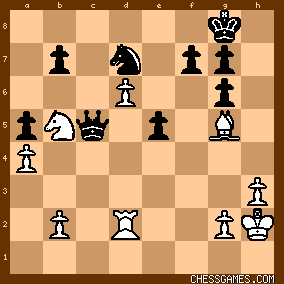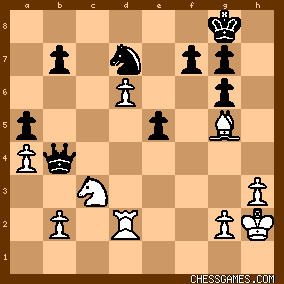Bridgeburner: <leachy>
Welcome back to chess and especially welcome to this place. I hope you enjoy yourself! This is certainly a chess site with a difference. <The only way to resurrect the whole thing is to play instead 25. Kg1 (the fork Ne4+ was threatened and also, if 25...Qc6 26. Rac1).> The entrenched pawn on d6 is certainly a headache, but one that can be dealt with as it doesn't have to tie down Black's pieces. After <25. Kg1> White can retain his Knight with <25...Ne4>. Alternatively, after <25...Qc6 26. Rac1>, Black could play <26...Rc2 27. Rxc2 Qxc2 28. Rd2 Qc5+ 29. Kh2 Nd7> and the pawn is now blockaded with the Knight and the queen is rampant: 
click for larger viewI think this is a matter of technique for Black to mop up, as White has too many vulnerabilities to protect. Say for example <30. Nc3> threatening <31. Rd5>. Black has moves like <31...f6>, <31...Qb4>, and even <31...e4>. If <31...Qb4>, then White's just about paralysed: 
click for larger viewThe Bishop has only one move to e3, (32. Be7 Qf4+ picks up the rook), the Rook is more or less confined to its square protecting both the second rank and the pawns on b2 and d6, and the Knight has to protect the a-pawn. Most importantly, White has no way of advancing the d-pawn. White has the advance of the king side majority including a central passed pawn with which to further squash White, eg: from the FEN diagram if <31. Be3 f5 32. g3 Kf7 33. Bg5 Ke6> followed by <...f4> in due course and Black's win "is a matter of technique". | 




